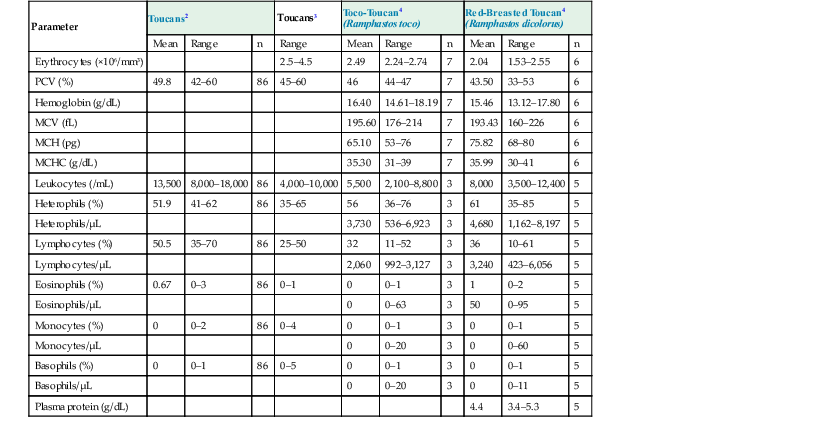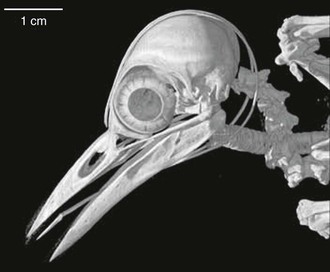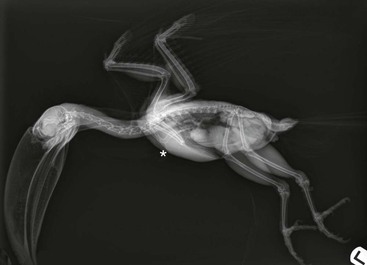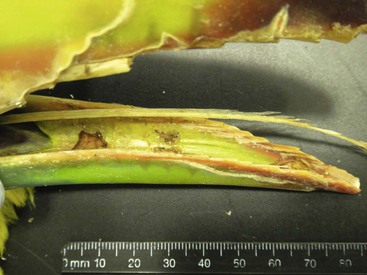John M. Sykes IV, The order Piciformes comprises four families: (1) Indicatoridae (honeyguides); (2) Capitonidae (barbets); (3) Picidae (woodpeckers); and (4) Ramphastidae (toucans, toucanets, aracari). The jacamars (Galbulidae) and puff birds (Bucconidae) are now considered part of the order Galbuliformes. Galbuliformes and Piciformes have historically been grouped together, as they are both zygodactylous and have similarities in tendon structure. However, the current thought is that zygodactyly has evolved separately in different taxa (including in Psittaciformes and Cucliformes), so this trait does not imply a close evolutionary relationship. Galbuliformes species are typically insectivorous, neotropical, perching birds and are not often kept in captivity.8 Piciformes species are zygodactylous (digits 2 and 3 point forward, and digits 1 and 4 point backward), have unique and similar flexor tendon pattern in the leg, have a well-developed sehnenhalter of the tarsometatarsal trochlea, have short incubation times, have altricial (naked and blind) young, are cavity nesters, and lack down feathers as adults.8,16,26 Honeyguides (Indicatoridae; 17 species; 10–20 centimeters [cm] long) are relatively small birds from sub-Saharan Africa and southern Asia. Wax, either in the form of a waxy coating of some insects or from honeybee nests, composes some portion of their diet. Adults have thickened skin, potentially as a protective mechanism against bee-stings, as they are not immune to this venom. They are brood-parasites, and their hatchlings will kill the host hatchlings. Barbets (Capitonidae; 82 species; 9–33 cm long) are pantropical and may be found in Asia, Africa, and Central and South Americas. They typically have a large head, short neck, and strong bills. Barbets are found primarily in forested areas and generally need a habitat with sufficient dead wood for excavation of nesting and roosting sites, although three species of the Trachyphonus genus nest in cavities in the ground. Woodpeckers (Picidae; 216 species; 8–50 cm long) have a cosmopolitan distribution (although not found in Australia or Antarctica). They are found typically in arboreal habitats such as tropical and temperate forests, but certain species live in sparsely treed areas, including deserts and rocky hillsides. The Ramphastidae family includes toucans, toucanets, and aracaris (34 species; 34–56 cm long). These birds are neotropical and found only in Central and South Americas. They typically have large brightly colored bills and are often found in the forest, although some species are present in woodlands and savannas. They typically nest in existing cavities, so their habitat may be limited by the presence of preexisting nest cavities.8 As honeyguides are not often kept in captivity, the rest of this chapter will focus primarily on toucans and provide available information on barbets and woodpeckers. Barbets have a short tongue with a brushy tip and bristles around the bill.8 Woodpeckers have anatomy designed to prevent head injury during hammering into wood, including a straight bill, specialized microstructure of the cranial bones to increase their strength, a modified hinge between the skull and mandible that redirects the force away from the brain, and modifications to the structure of the eye.8,34,40 These birds also have a long tongue, with sublingual glands that produce a sticky substance. The tongue muscles are supported by an extensive hyoid apparatus that extends around the back of the skull and over the head and may enter the nares in some species (Figure 30-1).8 Many woodpecker and neotropical barbet species are dimorphic.7,16 Toucans have serrated edges to their long and colorful bills. The bill is lightweight and composed of bony struts (Figure 30-2). Many functions have been proposed for this beak, including its use in courtship and foraging. One recent theory proposes that the beak may be used as an effective thermoregulator, similar to elephant ears.30 The tongue is laminated along the sides and tends to be brushlike toward the tip (Figure 30-3). The tail vertebrae are modified such that these birds may rotate the tail forward until it touches the head, and they often sleep in this position with the tail forward and the head curved back.8 Ramphastids also have a ventral deviation of the trachea at the thoracic inlet, which should not be interpreted as abnormal (see Figure 30-2). With the exceptions of some toucanets (Selenidera spp.), the green aracari (Pteroglossus viridis), and the lettered aracari (P. inscriptus), toucans are monomorphic. Toucans lack a crop.8 The nestlings of Piciformes species generally have some type of hypotarsal heel pad near the hock that they rest on the ground instead of standing on their feet. This feature fades as the nestlings mature.7,8 As both barbets and woodpeckers excavate their own nesting and roosting cavities, these species may be destructive to wooden structures. Some of this behavior may be redirected by including enrichment items such as soft or rotting logs in the enclosure. Care should be taken to keep the enclosure free of blind-ended tight cavities. Barbets have been known to enter cavities such as the ends of hollow bamboo or paper towel rolls and be unable to back out. Barbets are generally kept in pairs or family groups. It may be useful to drill pilot holes in logs to encourage nest excavation and breeding for barbets, although woodpeckers will often use preexcavated nest boxes. Many of the Piciformes species may be territorial during breeding.32 Toucans are very active and need an appropriate amount of space. These birds do occasionally prey on smaller birds, particularly nestlings, and so may be difficult to keep with other species, as they may eliminate the breeding potential of other birds in the exhibit. The most successful housing for breeding activity is a large private outdoor enclosure. Breeding pairs should be visually separated from each other. Some species are somewhat cold tolerant but are susceptible to frostbite and should be kept indoors during the colder months in temperate climates.16,32 Young birds may be prone to flying into mesh and damaging their bills, which are generally soft early in life. Care should be taken to avoid startling these young birds and to provide a large enough enclosure so that they can move away from people.32 Adults are active and curious, so they may trap their heads in small holes or forked branches and may ingest foreign objects in the enclosure.16 Ramphastids are reported to be particularly prone to yersiniosis, likely transmitted from rodents. Thus, food pans should be elevated off the ground, ideally on freestanding structures and preventive rodent control measures routinely employed.32 Barbets are primarily frugivorous but will eat arthropods. Woodpeckers are primarily insectivorous but will eat fruits, nuts, seeds, and sap. Toucans are primarily frugivorous. All these groups will feed insects, and often animal protein, to their nestlings. As toucans are particularly prone to hemochromatosis (iron storage disease), the iron in their diet should be limited. A number of low-iron complete pellets are commercially available. The appropriate upper limit of dietary iron is debatable. Pellets should contain less than 150 to 200 parts per million (ppm) iron,32 and the total iron content of the diet should probably be less than 40 ppm.7 Canine kibble is generally too high in iron for these birds. As in humans, highly acidic foods increase the absorption of iron from the stomach, so it is often recommended not to feed acidic fruits such as citrus, tomatoes, or strawberries to toucans.7,16,32 Some institutions attempt to use dietary tannins to help bind the iron and make it less available for absorption. Methods for adding these tannins include soaking the food in brewed tea or sprinkling tea leaves over the diet. It is unclear if these types of measures alter the uptake of iron in birds, but they are not likely to be particularly harmful.32 Restraint and medical techniques are similar to those for other birds. Some of the larger specimens may bite, so their heads should be restrained as for psittacines. Anesthesia is most often accomplished by using inhaled isoflurane. Custom-made masks (such as those made out of plastic soda bottles) are required to fit the long toucan beak into the mask to deliver the isoflurane to the nares. These birds may be easily intubated with an uncuffed endotracheal tube, although in the author’s practice, most toucans are maintained by using a laryngeal mask airway to decrease the risk of postintubation tracheal stenosis.29 Bill fractures are not uncommon in toucans. These wounds may be initially bandaged to control hemorrhage, and repair may be attempted with the use of dental restoratives and prosthetics.7 Blood may be collected from the right jugular vein or the ulnar vein in larger animals. Selected hematology and biochemical parameters are listed in Tables 30-1 and 30-2. TABLE 30-1 Hematology Values in Toucans1 1 Reprinted from Cubas ZS: Piciformes (woodpeckers, barbets, puffbirds, jacamars, toucans). In Fowler ME, Miller RE (eds): Zoo and wild animal medicine, 5th ed. Philadelphia, PA, 2003, Saunders, pp. 261–266.
Piciformes (Honeyguides, Barbets, Woodpeckers, Toucans)
Biology
Unique Anatomy
Special Housing Requirements
Feeding
Restraint, Anesthesia, Surgery, and Diagnostics
Parameter
Toucans2
Toucans3
Toco-Toucan4
(Ramphastos toco)
Red-Breasted Toucan4
(Ramphastos dicolorus)
Mean
Range
n
Range
Mean
Range
n
Mean
Range
n
Erythrocytes (×106/mm3)
2.5–4.5
2.49
2.24–2.74
7
2.04
1.53–2.55
6
PCV (%)
49.8
42–60
86
45–60
46
44–47
7
43.50
33–53
6
Hemoglobin (g/dL)
16.40
14.61–18.19
7
15.46
13.12–17.80
6
MCV (fL)
195.60
176–214
7
193.43
160–226
6
MCH (pg)
65.10
53–76
7
75.82
68–80
6
MCHC (g/dL)
35.30
31–39
7
35.99
30–41
6
Leukocytes (/mL)
13,500
8,000–18,000
86
4,000–10,000
5,500
2,100–8,800
3
8,000
3,500–12,400
5
Heterophils (%)
51.9
41–62
86
35–65
56
36–76
3
61
35–85
5
Heterophils/µL
3,730
536–6,923
3
4,680
1,162–8,197
5
Lymphocytes (%)
50.5
35–70
86
25–50
32
11–52
3
36
10–61
5
Lymphocytes/µL
2,060
992–3,127
3
3,240
423–6,056
5
Eosinophils (%)
0.67
0–3
86
0–1
0
0–1
3
1
0–2
5
Eosinophils/µL
0
0–63
3
50
0–95
5
Monocytes (%)
0
0–2
86
0–4
0
0–1
3
0
0–1
5
Monocytes/µL
0
0–20
3
0
0–60
5
Basophils (%)
0
0–1
86
0–5
0
0–1
3
0
0–1
5
Basophils/µL
0
0–20
3
0
0–11
5
Plasma protein (g/dL)
4.4
3.4–5.3
5

![]()
Stay updated, free articles. Join our Telegram channel

Full access? Get Clinical Tree


Piciformes (Honeyguides, Barbets, Woodpeckers, Toucans)
Chapter 30



